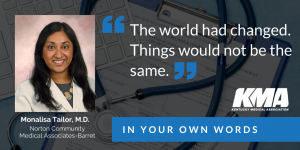The Coronavirus Aid, Relief, and Economic Security (CARES) Act established or expanded several loan programs to assist small businesses, including physician practices, that have been severely impacted by the COVID-19 emergency. The Economic Injury Disaster Loan (EIDL) and the corresponding EIDL Emergency Advance can be used to assist practices with payroll expenses, accounts payable, and other operating expenses that could have been met had the disaster not occurred.
KMA has created a one-page guide, available here, on this program as a resource for physicians. KMA expresses no opinion as to the feasibility, applicability, or impact to your particular practice.
Telehealth and Other Virtual Care Documentation Reminders During COVID-19
Medicare, Medicaid, and commercial insurers continue to announce new flexibilities and expand telehealth coverage in response to the COVID-19 emergency. While telehealth services have expanded rapidly, the documentation requirements for any form of virtual care (telehealth service or non-telehealth digital online service) remain the same as those for documenting in-person care.
KMA has created a reference handout, available here, with reminders and resources for physicians when billing for telehealth.
In addition, KMA’s COVID-19 website contains information on the new telehealth guidance by payor, as well as the various financial resources available to physicians through the grant and loan programs established or expanded by the Coronavirus Aid, Relief, and Economic Security (CARES) Act and the Coronavirus Economic Stabilization Act (CESA).
In Your Own Words: Monalisa Tailor, M.D.
KMA is sharing the first-person accounts of physicians from across the state as they prepare for and battle the COVID-19 pandemic. These stories will also be published at kyma.org/covid19. If you are interested in submitting an account, please email Emily Schott, schott@kyma.org.
 The weekend of March 15th, 2020, I will not forget it. Maybe it was the conversation on the Facebook Louisville Lady Doc group or maybe it was the realization of what was happening in Italy hitting all at once. The world had changed. Things would not be the same.
The weekend of March 15th, 2020, I will not forget it. Maybe it was the conversation on the Facebook Louisville Lady Doc group or maybe it was the realization of what was happening in Italy hitting all at once. The world had changed. Things would not be the same.
That following week was a roller coaster as an outpatient physician. No more handshakes and having routine conversations about physicals, preventative care, and hypertension. On Wednesday, March 18th, I saw a lady for “sore throat, chills, lethargy.” She said her symptoms started 3 days ago. She was having chills at night and coughing. My patient is typically very well dressed with jewelry to match her beautiful clothes. The part of her story that struck me: “I got winded getting dressed for today’s appointment. I had to sit down and collect myself before I came to see you.” That did not fit. This was not a typical sinus infection. This was not bronchitis. This was something different. My voice quivered, “I think you have it.”
I spent the next 15 minutes shaking while putting together a plan for my patient and instructions for isolation. The worst feeling of helplessness for an internist is being unable to offer a definitive treatment for a patient. That’s how I felt. I was throwing things at her and hoping something would stick. I went back to talk to her about a plan and answered her questions. Her final question to me, “Am I your first?” My eyes gave me away, “Yes ma’am.” I knew she would not be my last. I went home that day and cried. I just hoped I could do the best for her to manage at home so she would not have to go to the hospital. I continue to carry that same hope for my patients who are suffering from COVID-19.

